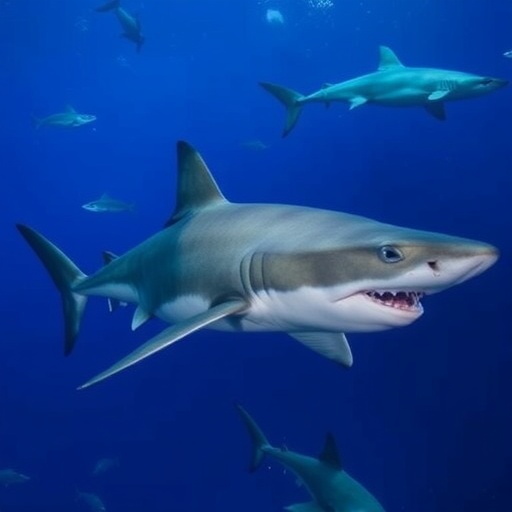For over 400 million years, sharks have navigated Earth’s oceans as a hallmark of evolutionary success and ecological complexity. From the minuscule dwarf lanternsharks to the colossal whale sharks that dwarf buses, this group exhibits extraordinary phenotypic diversity. Apex predators such as great whites and hammerheads play indispensable ecological roles, maintaining the balance and health of marine ecosystems by regulating prey populations and facilitating nutrient cycling. However, an emerging crisis threatens to erode this remarkable variety, with current extinction trajectories poised to homogenize shark morphology and ecological function on a global scale.
Recent scholarship spearheaded by researchers at Stanford University draws on comprehensive data from the International Union for Conservation of Nature’s Red List, focusing on a representative genus, Carcharhinus. This genus, comprising 35 recognized species, includes emblematic sharks like the bull shark and the oceanic whitetip—both renowned and vulnerable. Of these, 25 species face significant extinction risk, classified under threat categories such as Vulnerable, Endangered, or Critically Endangered. The researchers applied rigorous statistical morphometric analyses to over 1,200 shark teeth, a functional proxy for overall body size and dietary specialization, revealing non-random extinctions biased toward species with specialized morphologies and ecological niches.
Shark teeth morphologies offer an insightful window into species’ ecological roles. Larger teeth correlate with body size, influencing swimming dynamics and feeding strategies, while fine structural features such as serrations signal prey selection. The findings underscore a disturbing trend: sharks possessing extreme morphological traits—those adapted to life near the ocean surface or abyssal zones—are disproportionately imperiled. In contrast, medium-sized generalists, occupying mid-water ocean strata with broader dietary habits, show comparatively greater resilience. This selective pressure foreshadows a future where sharks may converge morphologically, losing the breadth of functional diversity that characterizes this group.
Ecologically, this “phenotypic homogenization” portends significant consequences. Unique traits among specialized shark species underpin ecosystem stability, for instance through predation patterns that modulate biodiversity and energy flow. Loss of these traits equates to a pruning not just of species but of ecosystem functionalities that have been fine-tuned through hundreds of millions of years of evolutionary history. The projected reduction to a narrow spectrum of mid-sized, generalist sharks threatens to weaken marine food webs and disrupt biogeochemical processes essential to ocean health.
From a biomedical and biomaterial perspective, biodiversity also represents a reservoir of evolutionary solutions with untapped potential. Unique shark morphologies, honed for diverse environmental challenges, may harbor novel biochemical compounds or structural adaptations applicable to human medicine, engineering, and technology. The extinction-driven erosion of morphological diversity curtails these avenues of innovation just as urgently as it diminishes natural heritage, underscoring ethical and practical imperatives for conservation.
The researchers acknowledge that underlying drivers of global shark declines are multifaceted, including habitat degradation and pollution. Yet, overfishing remains the predominant threat, exacerbated by insufficient regulatory enforcement and unsustainable fishing practices. Historical analogs such as the dramatic recovery of northern elephant seal populations after hunting bans demonstrate that targeted conservation interventions can yield rapid ecological rebounds. These success stories bolster hope that reversing shark declines is achievable through robust international cooperation, stringent fisheries management, and the curtailment of illegal harvests.
Practically, halting the decline of shark populations demands not only legislative action but also shifts in public attitudes and consumer behavior. Awareness campaigns emphasizing the ecological roles of sharks and the consequences of their loss can galvanize support for conservation. Furthermore, habitat protections, including the establishment of marine protected areas that encompass critical shark breeding and feeding grounds, are indispensable strategies for maintaining population viability and functional diversity.
The Stanford-led study heralds a call to action by elucidating the complex interplay between extinction risk, morphology, and ecological roles within a critical shark genus. By integrating morphometric analyses with conservation status data, it presents a nuanced narrative that highlights the disproportionate vulnerability of evolutionary specialists and portends the homogenization of shark communities without timely intervention. This work enriches our understanding of extinction dynamics and underscores the urgency of preserving deep ecological and morphological diversity.
Importantly, this research situates shark conservation within broader global biodiversity frameworks, illustrating parallels with declines in other taxa such as vultures and coral reef species implicated by predators like sea urchins. The homogenizing trend in sharks mirrors broader patterns where ecosystem simplification follows the loss of specialized species—a trajectory detrimental to ecosystem resilience under accelerating environmental changes.
Ultimately, this emerging picture of shark decline is not just a marine conservation issue but a metaphor for the broader biodiversity crisis precipitated by human activities. Conservation strategies that emphasize the protection of ecological specialists, coupled with sustainable exploitation policies, constitute our best hope to sustain the intricate web of life in the oceans. The restoration of shark diversity and function can safeguard marine ecosystems, preserve evolutionary heritage, and maintain ecological services vital to planetary health.
Jonathan Payne, senior author and professor at Stanford’s Doerr School of Sustainability, eloquently captures the implications: the loss of shark diversity equates to erasing millions of years of evolutionary progress. The simplification of marine predator communities into more uniform forms diminishes complexity and robs future generations of both natural wonders and evolutionary innovations. Yet, as history attests, decisive action and restraint can foster remarkable recoveries, enabling sharks—and the ecosystems they anchor—to thrive once more.
Subject of Research: Extinction impacts on morphological and ecological diversity in shark populations, with a focus on the genus Carcharhinus, analyzed through morphometric data of shark teeth and IUCN Red List conservation statuses.
Article Title: Extinction Threatens to Cause Morphological and Ecological Homogenization in Sharks
News Publication Date: 29-Oct-2025
Web References:
– IUCN Press Release on Sharks, Rays, and Chimaeras Threatened with Extinction: https://iucn.org/press-release/202412/third-sharks-rays-and-chimaeras-are-threatened-extinction-new-report-narrows
– DOI Link to Article in Science Advances: http://dx.doi.org/10.1126/sciadv.aea0278
References:
Bazzi, M., Payne, J. et al. (2025). Extinction Threatens to Cause Morphological and Ecological Homogenization in Sharks. Science Advances. DOI: 10.1126/sciadv.aea0278
Keywords: sharks, extinction, morphological diversity, ecological homogenization, apex predators, Carcharhinus genus, overfishing, marine ecosystems, conservation, biodiversity loss, phenotypic homogenization, evolutionary biology




